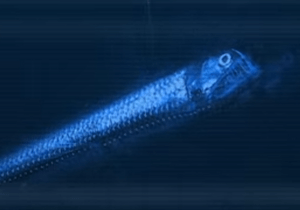Viperfish facts for kids
Quick facts for kids Viperfish |
|
|---|---|
 |
|
| Dana viperfish, Chauliodus danae | |
| Scientific classification |
|
| Kingdom: | Animalia |
| Phylum: | Chordata |
| Class: | Actinopterygii |
| Order: | Stomiiformes |
| Family: | Stomiidae |
| Subfamily: | Stomiinae |
| Genus: | Chauliodus Bloch & J. G. Schneider, 1801 |
| Species | |
|
See text |
|
A viperfish is a type of deep-sea fish found in the ocean. These amazing creatures are known for their very long, sharp, needle-like teeth and lower jaws that can swing open wide. A typical viperfish usually grows to be about 30 to 60 centimeters (12 to 24 inches) long.
Viperfish live in the deep parts of the ocean during the day, usually between 250 to 5,000 feet (76 to 1,524 meters) down. At night, they swim up to shallower waters. You can find them mostly in warm, tropical, and mild ocean areas.
These fish are thought to hunt by luring their prey close with special light-producing organs called photophores. These lights are found along the bottom of their bodies. They also have a special light at the end of a long spine on their back fin, much like an anglerfish uses its "fishing rod." The viperfish flashes this natural light on and off, moving its back spine like a fishing lure while staying perfectly still in the water.
Viperfish can be different colors, from green to silver or even black. They use their fang-like teeth to grab and hold prey when they charge at high speeds. The first bone behind their head helps absorb the shock when they bite. Like other deep-sea fish, viperfish can go for a long time without much food.
Scientists believe viperfish can live for 30 to 40 years in the wild. However, they rarely survive more than a few hours if caught and brought into captivity. Some dolphins and sharks are known to hunt viperfish.
Even though it might look like they have scales, viperfish are covered by a thick, clear layer of something unknown. Their very large, fang-like teeth make their lower jaw stick out a bit, which helps them catch food easily. Viperfish have three different kinds of photophores, which many think they use to attract prey. These lights are also found along the bottom and sides of the fish.
Where Viperfish Live
Viperfish live in very deep parts of the ocean, called the bathypelagic zone. This area is so deep that it's hard for humans to explore, so we don't know a lot about their daily lives. They are found at depths from 1,000 to 5,000 meters (3,300 to 16,400 feet), where the water is usually around 4 degrees Celsius (39 degrees Fahrenheit).
Viperfish are thought to move up and down in the water each day. This is called a diel vertical migration. They have been seen in the mesopelagic zone at night, which is a bit shallower (up to 200 meters or 660 feet deep) and is just above their usual deep-sea home.
How Viperfish Eat
Viperfish hunt and eat small ocean creatures like shrimp, small fish, and squid. When scientists have looked inside the stomachs of captured viperfish, they found things like lanternfish, bristlemouthes, and other small fish. This suggests that viperfish attack and swallow whatever prey they come across.
With their dark or silvery colors, they can blend in and become almost invisible. They have been seen staying perfectly still for hours, waiting to strike at unsuspecting prey. Once they catch something, they use their long teeth to pierce and kill it, then swallow it whole.
The photophores along the viperfish's belly are used for something called "counter illumination." This means they use their light to match the dim light coming from above, helping them hide from predators that might be looking up from below. The viperfish also uses this light to attract its prey through bioluminescence, which is light made by living things. By flashing the light on and off, it works like a fishing lure to attract smaller fish.
Types of Viperfish
There are currently nine types of viperfish that are still alive today:
- Chauliodus barbatus Garman, 1899
- Chauliodus danae Regan & Trewavas, 1929 (Dana viperfish)
- Chauliodus dentatus Garman, 1899
- Chauliodus macouni T. H. Bean, 1890 (Pacific viperfish)
- Chauliodus minimus Parin & Novikova, 1974
- Chauliodus pammelas Alcock, 1892
- Chauliodus schmidti Ege, 1948
- Chauliodus sloani Bloch & J. G. Schneider, 1801 (Sloane's viperfish)
- Chauliodus vasnetzovi Novikova, 1972
Scientists have also found fossils of at least two more types of viperfish from the Late Miocene period (a long time ago!):
- Chauliodus eximus, (Jordan, 1925), originally called Eostomias eximus, found in Late Miocene California.
- Chauliodus testa, Nazarkin, 2014, found in the Late Miocene of Western Sakhalin Island.
See also
 In Spanish: Peces víbora para niños
In Spanish: Peces víbora para niños

